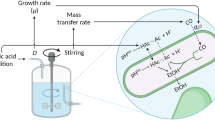Abstract
Combined gasification and fermentation technologies can potentially produce biofuels from renewable biomass. Gasification generates synthesis gas consisting primarily of CO, CO2, H2, N2, with smaller amounts of CH4, NOx, O2, C2 compounds, ash and tars. Several anaerobic bacteria species can ferment bottled mixtures of pure synthesis gas constituents. However, there are challenges to maintaining culture viability of synthesis gas exposed cells. This study was designed to enhance culture stability and improve ethanol-to-acetate ratios using resting (non-growing) cells in synthesis gas fermentation. Resting cell states were induced in autotrophic Clostridium ljungdahlii cultures with minimal ethanol and acetate production due to low metabolic activity compared to growing cell production levels of 5.2 and 40.1 mM of ethanol and acetate. Clostridium autoethanogenum cultures were not induced into true resting states but did show improvement in total ethanol production (from 5.1 mM in growing cultures to 9.4 in one nitrogen-limited medium) as well as increased shifts in ethanol-to-acetate production ratios.





Similar content being viewed by others
References
Abrini J, Naveau H, Nyns E (1994) Arch Microbiol 161:345–351
Barik S, Prieto S, Harrison SB, Clausen EC, Gaddy JL (1988) Appl Biochem Biotechnol 28:363–378
Berberich JA, Knutson BL, Strobel HJ, Tarhan S, Nokes SE, Dawson KA (2000) Ind Eng Chem Res 39:4500–4505
Bryant MP (1972) Am J Clin Nutr 25:1324–1328
Cotter PD, Hill C (2003) Microbiol Mol Biol Rev 67(3):429–453
Datar RP, Shenkman RM, Cateni BG, Huhnke RL, Lewis RS (2004) Biotechnol Bioeng 86(5):587–594
Eriksson T, Borjesson J, Tjerneld F (2002) Enzyme Microb Technol 31(3):353–364
Förberg C, Enfors SO, Haggstrom L (1983) Appl Microbiol Biotechnol 17(3):143–147
Fordyce AM, Crow VL, Thomas TD (1984) Appl Environ Microbiol 48(2):332–337
Gaddy JL, Clausen EC (1992) US Pataent 612:221
Gottwald M, Gottschalk G (1985) Arch Microbiol 143:42–46
Kini KA, Lahiri A (1975) J Sci Ind Res 34(2):97–99
Klasson KT, Ackerson MD, Clausen EC, Gaddy JL (1992) Enzyme Microb Technol 14:602–608
Larsson C, Stockar U, Marison I, Gustafsson L (1993) J Bacteriol 175(15):4809–4816
Lebloas P, Guilbert N, Loubiere P, Lindley ND (1993) J Gen Microbiol 139:1861–1868
Mielenz JR (2001) Curr Opin Microbiol 4(3):324–329
Monot F, Engasser JM (1983) Biotechnol Lett 5(4):213–218
Najafpour G, Younesi H (2006) Enzyme Microb Technol 38:223–228
Padan E, Zilberstein D, Schuldiner S (1981) Biochim Biophys Acta 650:151–166
Phillips JR, Clausen EC, Gaddy JL (1994) Appl Biochem Biotechnol 45(46):145–157
Rao G, Mutharasan R (1987) Appl Environ Microbiol 53(6):1232–1235
Rao G, Mutharasan R (1988) Biotechnol Lett 10(2):129–132
Saha SK, Sivasanker S (1992) Indian J Technol 30(2):71–76
Stiles AB, Chen F, Harrison JB, Hu X, Storm DA, Yang HX (1991) Ind Eng Chem Res 30(5):811–821
Tanner RS, Miller LM, Yang D (1993) Int J Syst Bacteriol 43(2):232–236
Terracciano JS, Kashket ER (1986) Appl Environ Microbiol 52(1):86–91
Thomsson E, Larsson C, Albers E, Nilsson A, Franzén GL (2003) Appl Environ Microbiol 69(6):3251–3257
Vasconcelos I, Girbal L, Soucaille P (1994) J Bacteriol 176(3):1443–1450
Vega JL, Prieto S, Elmore BB, Clausen EC, Gaddy JL (1989) Appl Biochem Biotechnol 20(21):781–789
White H, Lebertz H, Thanos I, Simon H (1987) FEMS Microbiol Lett 43(2):173–176
Ying Z, Yang ST (2004) J Biotechnol 110(2):143–157
Younesi H, Najafpour G, Mohamed AR (2005) Biochem Eng J 27:110–119
Acknowledgments
The authors acknowledge the financial support of the North Carolina State University Faculty Research and Professional Development Grant.
Author information
Authors and Affiliations
Corresponding author
Rights and permissions
About this article
Cite this article
Cotter, J.L., Chinn, M.S. & Grunden, A.M. Ethanol and acetate production by Clostridium ljungdahlii and Clostridium autoethanogenum using resting cells. Bioprocess Biosyst Eng 32, 369–380 (2009). https://doi.org/10.1007/s00449-008-0256-y
Received:
Accepted:
Published:
Issue Date:
DOI: https://doi.org/10.1007/s00449-008-0256-y




